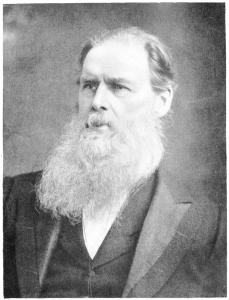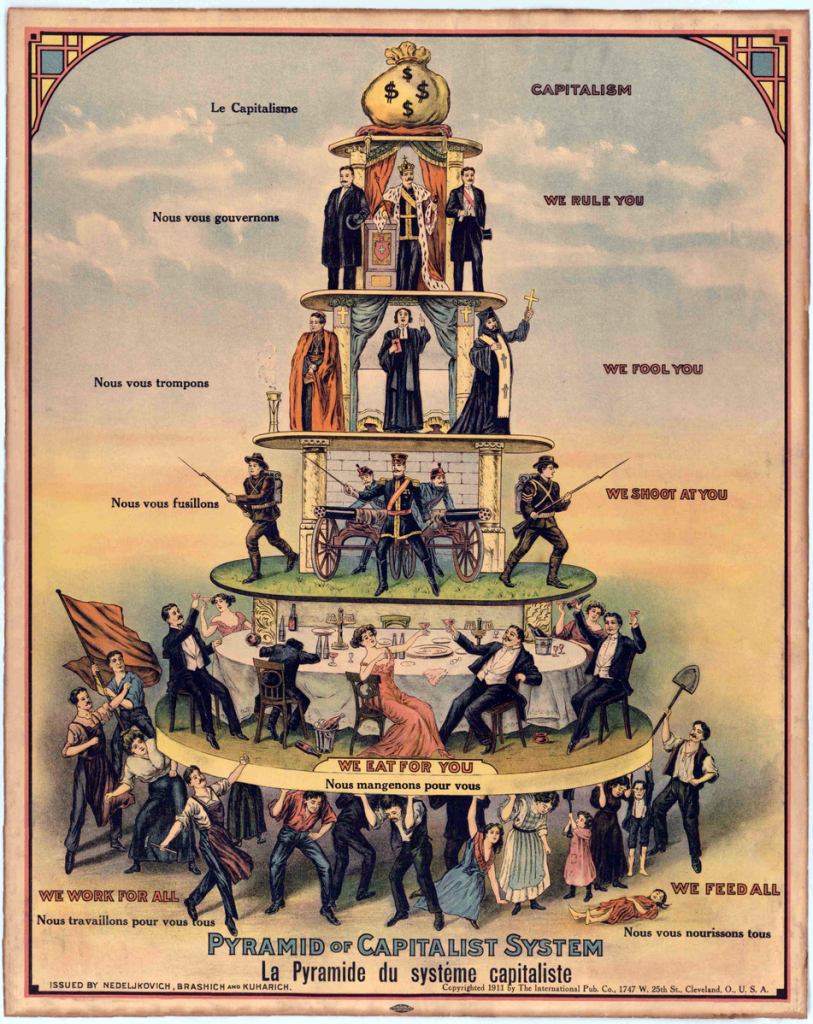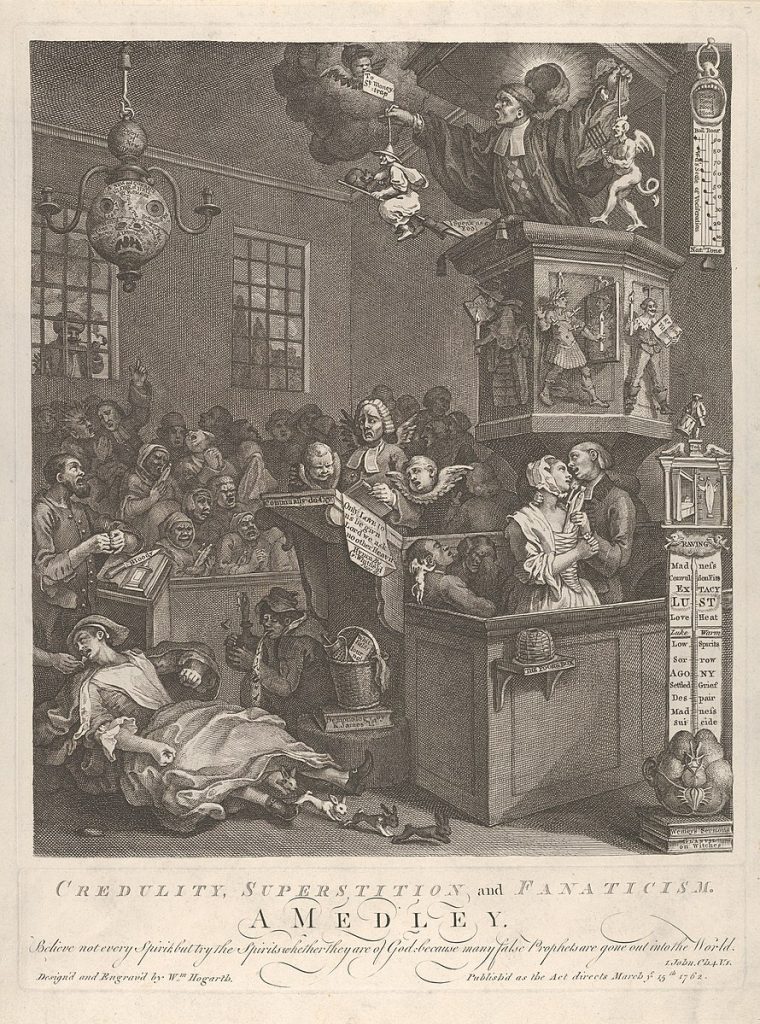3 Theoretical Approaches Toward the Study of Religion
Chapter 3 audio can be accessed on Soundcloud. Instructor resources are available on Canvas Commons.

Chapter 3 Learning Objectives
At the end of this chapter, you’ll be able to:
- Summarize and interpret definitions of religion made by foundational figures in social science and anthropology.
- Compare and contrast arguments about functions of religion in human societies.
3.1 Setting Goals for the Anthropological Study of Religion
Before we begin our discussion on the approaches that anthropologists and other social scientists use when they study religion, it’s important to understand that these disciplines are not interested in the truth or falsity of any given religion (Guest 2020, 61). Due to the very nature of religious phenomena as faith-based and scientifically unprovable, there is no way to examine which religions are “true” or “false,” or which types of magic “work” or “do not work.”
We are similarly not here to judge which religions are better or worse, because all religions make sense within their own culturally-specific contexts. So, as we examine the different beliefs that exist across world religions, it’s essential that you approach each with an open mind. Try to separate your own religious beliefs from your study of other religions and do not measure them against your own culturally-specific standards.
3.2 Edward Burnett Tylor
In the next sections of this chapter, we explore key questions and interpretive frameworks that anthropologists use when they study religion across human cultures. Themes we outline here reflect centuries of discussion and heated debate among social scientists. One of these social scientists was Edward Burnett Tylor, an early British anthropologist who lived from 1832 – 1917. Born in England as a member of a religious minority group called Quakers (a branch of the Christian faith), he grew up to view religions as cultural structures rather than systems of belief. This view prepared him to be one of the world’s first scholars on the matter of religion (Moore 2019, 4).

Tylor is popularly called “the founder of modern anthropology.” Among other contributions (see below), he was one of the early scholars in the social sciences who attempted a definition of “culture” that was clear enough to enable scientific inquiry but also broad enough to reflect the complexity of human behavior. He organized our field as an inquiry into human social systems (Moore 2019, 3-4), and separated this type of research and analysis (anthropology) from biological fields of study (Kuper 2014, 3).
3.3 Why Magic Works
Tylor examined the logic that existed within societies that he considered to be “less evolved” than his own in order to make sense of their beliefs in their own terms (Kuper 2014, 25). One topic of interest to Tylor was the widespread belief in magic (recall that the term magic was defined in Chapter 1). In order to explain why forms of magic were taken seriously in so many societies, Tylor identified four ways that beliefs in magic were reinforced:
- Randomly, the desired results of a magical ritual will sometimes occur, causing believers to think that the magic practice is effective.
- Sometimes, a person performing the magic will use deception to convince participants that their ritual has been effective.
- People tend to remember positive outcomes more often than the occasions when magic doesn’t work.
- When magic doesn’t produce the desired results, believers often blame counter-magic from someone else (Winick 2014, 334). Thus, the failure of a magical ritual can actually be interpreted by cultural insiders as a justification for more – or stronger – magic to be used in the future.
For Tylor, these processes occurred uniquely in societies he viewed as “primitive” (these tended to be non-European societies). Tylor’s view that non-European societies were inherently different than the rest of the world was not only racist, but it is also safe to say that his ethnocentrism prevented him from understanding that people in all cultures can and do buy into perpetuate magical beliefs of different kinds. Again, today’s anthropologists consider the existence of these characteristics and processes as universal. Consider the following points from Rebecca and Phillip Stein’s textbook on “The Anthropology of Magic, Witchcraft, and Religion,” which expands upon the idea of “why magic works.”
- The human mind frequently sees coincidence as evidence of causation. We might assume that two, unrelated events are causing one another (even in cases where the two events are not related).
- Magic often attempts to cause outcomes that happen naturally. For example, people are unlikely to perform a rain ritual outside of the rainy season. So, when the rain ritual is performed immediately before the rains naturally start, a community might associate the magic with the outcome.
- As humans, we are very resistant to changing our beliefs! Overcoming the long-held belief that magic exists can be very hard to overcome.
- Practitioners of magic typically do not ask impossible things of magic. Magical beliefs and practices are usually restrained to the realm of possibility.
As defined in Chapter 1, magic refers to any efforts made to change one’s life by supernatural means. Magic, in this sense, is practiced in nearly all religions and can be examined in a variety of contexts.
3.4 Cultural Evolutionism, Animism, and Diffusionism
In his most famous work, Primitive Culture, Tylor outlined two key ideas . Please note that both of Tylor’s ideas are overly simplistic by the standards of modern religious scholars. While neither fully reflect modern anthropological thinking, both influenced early anthropological work and carry a small piece of validity that you may wish to revisit throughout the course.
- Cultural Evolutionism: The idea that cultures change and adapt over time to meet people’s changing needs (Winick 2014, 196).
- Animism: Attributing a soul, a force, power, or personality to animate and inanimate objects like stones, plants, or the sun (Winick 2014, 26; Durkheim 2008, 27).
Specifically, Tylor argued that all societies believed that the soul continues on, in some form, after death (Tylor 2016, 1-43). Tylor specifically highlighted a belief in transmigration, or the belief that a spirit can move from one body to another (in the form of reincarnation, for example). Tylor argued that all human societies first develop the idea of a soul when they struggle to understand what is happening to them when they are dreaming (Durkheim 2008, 47).
Please note that Tylor’s work was problematic in many ways. His most famous work, “Primitive Cultures” refers to non-European societies as “lower races” and “savages,” and he held the belief that societies evolve toward an inevitable form: “civilization.” This idea shaped his conception of human cultural variation, our collective history, and our future.
Tylor wrote extensively on the languages that he encountered abroad and labeled some forms of language as “degenerative” (Moore 2019, 5). He also strove to identify distinct ‘races’ of humans, and argued that members of these different groups were fundamentally different from one another in terms of their physical, intellectual, and ethical abilities (King 2020, 38-39; Stein and Stein 2010, 17). Similarly, he considered many non-European cultural practices to be “child-like” behaviors (Durkheim 2008, 50).

“Set of wooden figurines on steps” by Susanne Jutzeler
Tylor and his contemporaries developed a theoretical approach modern scholars refer to as evolutionism. Before we define the term “evolutionism,” it is important to note that evolutionism arose in response to another theoretical approach: diffusionism. Both of these approaches answer the question “why are there similarities and differences between human societies?”
Diffusionism views ‘cultural patterns’ (practices, beliefs, and styles) as moving across trade and migration routes because people share and spread them (Winick 2014, 168). Diffusionists embrace the idea that “greater” civilizations are able to spread their cultural forms across the globe. Thus, a diffusionist explanation of human history sees cultural variation as the result of practices, beliefs, or styles spreading into new areas, where they are adopted wholesale or modified slightly to fit local traditions. Every culture, in the diffusionist view, is at least in part the result of borrowing and adoption from other cultures.
In contrast, evolutionism argues that cultures develop or change in order to adapt to their own surroundings, building on their own pre-existing adaptations. According to this way of seeing human cultural variation, similarities emerge between groups because human nature leads people everywhere to solve similar problems in similar ways, and to change in a predictable and linear manner.
While these two approaches to the study of cultural variation were initially considered to be at odds, in reality, human cultures are likely the product of both ever-evolving adaptations and contact through migrations and trade across the globe (Moore 5).
3.5 Critiquing Tylor
Tylor’s ideas, as outlined above, are in many ways representative of the viewpoints that were widespread among early anthropologists. In hindsight, and owing to generations of scholars who have responded to the various problematic elements of these ideas, we can offer the following critiques:
- Tylor’s cultural evolutionism purported that human cultures inevitably change and evolve over time. We know that it is true that cultures evolve over time, but Tylor specifically argued that cultures (and religions) evolved in a linear manner. In other words, Tylor was of the view that all religions would evolve from spirit worship, to polytheism, to monotheism (this was, obviously, because he believed in a monotheistic religion and felt that his religion was the most “advanced”). In fact, religions and cultures do not evolve in any kind of predetermined, linear manner. Furthermore, there is no such thing as a more or less evolved or advanced culture (these are all culturally-specific ideas).So, we do still consider Tylor’s ideas to be important, because cultures do evolve and adapt. But they do so in a variety of directions. Thus, we do not embrace the idea that cultures evolve in a linear manner (Reed 1955, 322-323).
- Tylor established the idea of animism or the idea that all religions share one thing in common: the belief in spirits (Stocking 1968, 103). For Tylor, spirits might manifest as human souls, as the power of the Gods/divine, or as the spirits of nature. While this is an interesting argument, we know that some forms of Buddhism do not actually believe in any spirit beings at all (not even the human soul).
Furthermore, some people believe in supernatural spirit beings such as the existence of leprechauns, ghosts, or guardian angels but they may not belong to an organized religion that governs these beliefs. So, while the term “animism” is helpful to discuss a common thread across religions, it’s not a universal or exclusive characteristic that can be applied to all religions in all cases.
3.6 Social Darwinism
Social Darwinism is a political theory that likens cultural change to biological change, and is loosely related to Tylor’s ideas surrounding the evolution of religion and culture. Social Darwinists believe that society naturally places “stronger people” in a place of privilege and power, and that global politics and competition naturally place “stronger cultures” in similar positions.
According to this view, disparities in social status and power are natural and inevitable, with some cultures naturally dominant and others naturally dominated. This domination can take many forms, including the military conquest of one group by another, as well as political or economic control.
Archaeologist Eric Reed critiqued cultural evolutionism in his commentary titled, “Diffusionism and Darwinism” (Reed 1955). Reed explained that evolutionists were seeking a “psychic unity of mankind” in the following three flawed steps:
- Loosely identifying trends in human societies.
- Developing overarching themes intended to establish common threads of humanity.
- Attempting to force the remainder of human societies into the evolutionary framework previously established.
Reed pointed out that biological evolution does not translate to cultural life and cannot be used to explain cultural changes over time. Biological anthropologists know that evolution happens in organisms because it’s demonstrated in the fossil record, can be witnessed in some organisms within a human lifespan, and is evident in the biological diversity of life. Conflating biological processes with cultural trends sometimes manifests in social Darwinism, which argues that the most powerful in a society should always maintain the power. This pseudo-scientific belief has led to human rights abuses throughout human history and must similarly be critiqued when it is present in anthropological history.
3.7 Robert Marett and Animatism
Robert R. Marrett (1866-1943) was, like Tylor, an early anthropologist who studied religion and who adopted an evolutionary approach. In Marett’s view, the first form of religion was a belief in an ever-present and ubiquitous force that gave power to all elements of life (Durkheim 2008, 203). Marett called this concept mana, a term used in Polynesia and Melanesia to describe the supernatural forces involved in ritual (Winick 2014, 341; McCurdy et al. 2016, 25).
Marret argued that supernatural, spiritual, and religious beliefs emerge when human beings are overwhelmed by the absolute power of nature. When we cannot explain how the universe around us works, we strive to make sense of it through constructions of the mind. Marrett called this animatism, and it refers to the supernatural powers like mana (Winick 2014, 26). According to Durkheim’s summary of Marrett’s arguments, animatism arises in the face of “anything that makes us feel admiration or fear (Durkheim 2008, 203).”
3.8 Marxism
Among other things, historian Karl Marx is well-known for writing The Communist Manifesto along with Friedrich Engels in 1848. The Manifesto is a critique of the capitalist system of production that, in what came to be known as the Marxist view, commodifies workers for the benefit of those who possess far greater wealth. Marx and Engels’ works examined the historical evolution of modern economic systems and highlighted the power imbalances within capitalism. In doing so, they also laid out a holistic model of how political and economic forces have interacted with belief systems and even with religion over time.
The Marxist viewpoint posits that under capitalism, less wealthy people leave their families and communities every day in order to produce more wealth for the most powerful members of their society. This perspective on money and power is increasingly mainstream as more information about income inequality enters the realm of popular culture. As Oxfam highlighted in January 2020, “The world’s 2,153 billionaires have more wealth than…4.6 billion people who make up 60% of the planet’s [poorest communities].” When only 2,000 people have as much money and power as 60% of the rest of humanity, what makes workers continue to show up for work?

Marx argued that religion, as an ideology, maintains this system of inequality. In Marx’s view, those without wealth or power continue to work for low wages for many reasons, but one is specifically based on belief; they have internalized the idea that any type of work is, itself, an inherent moral value. Within a religious, capitalist culture, people work to benefit the rich because they may even believe that we will be rewarded in the afterlife (for more on this, see the section on the work of Max Weber in Chapter 10).
For a more in-depth understand of the relationship between anthropology and Marxism, read the following: “Marxism and Anthropology,” “Examining Class Struggle,” and, “Marxism and Feminism.”
3.9 “The Opium of the People”
Marx once described religion as the opium of the people which is a commonly cited and commonly misunderstood quote. Many dictatorial regimes have, historically, misappropriated this Marxist argument to justify a violent crackdown on religion in their countries. At the time of Marx’s claim, opium was legal and was widely used to relieve pain. So, he was not arguing that religion was some kind of addictive drug that causes people to behave in an unreasonable manner. Rather, he was arguing that religion was a comfort to people who were suffering (Stein and Stein 2010, 18).
Marx’s exact quote on the matter is,
“Religious suffering is, at one and the same time, the expression of real suffering and a protest against real suffering. Religion is the sigh of the oppressed creature, the heart of a heartless world, and the soul of soulless conditions. It is the opium of the people. The abolition of religion as the illusory happiness of the people is the demand for their real happiness. The demand to give up the illusion about its condition is the demand to give up a condition which needs illusion.” (Marx 1970).
Marx and Engels did not view religion as an inherent part of human nature, but rather as a construction offered by powerful groups in order to maintain the false consciousness necessary to keep workers working (Stein and Stein 2010, 18). Marx argued that power flows from the top of society downward to influence the internalized ideologies of those with less power (Mascia-Lees 2010, 157).
Marx and Engels’ works have had a variety of influences across the world since their original publications: socialism has taken hold in a variety of degrees across the world with varying levels of success. At the same time, socialism has been rejected in other parts of the world, resulting in a strengthened cultural commitment to capitalism (also with varying levels of success).
Within the field of anthropology, Marx and Engels’ influence resulted in a new theoretical approach toward the study of culture which we call the Marxist Approach (Kuper 2014, 182-183). The Marxist Approach examines power imbalances that exist within and across cultures. Specifically, the Marxist Approach considers how material conditions (or, the production of things that people need to survive) lead to the spread, or elimination, or maintenance of particular cultural trends, beliefs and traditions.
3.10 Clifford Geertz and Symbolism
Clifford Geertz was an American anthropologist who strove to understand how human societies construct and engage with symbols used to convey layers of meaning in life. Geertz established his own definition of religion, as outlined in his book, The Interpretation of Cultures. He defines religion as:
“A system of symbols which acts to establish powerful, pervasive, and long-lasting moods and motivation in [people] by formulating conceptions of a general order of existence and by clothing these conceptions with such an aura of factuality that the moods and motivations seem uniquely realistic.” (Geertz 1972, 97).
What his definition means is:
- Religion is a system of symbols. When we look at our own religions, we can see a variety of symbols that are quite literal, and then other symbols which are more powerful and which reflect our ideologies. Consider, for example, if you have entered a Christian church before, you may have seen a crucifix on the wall. The crucifix represents the death of Jesus Christ, a supernatural being at the center of the Christian faith. This is a literal symbol. However, Christ’s crucifixion symbolizes a much more important set of values that are central to Christianity including: God’s unending love for humanity and immense suffering to gain forgiveness for humanity.
- These symbols (both large and small) establish certain moods and motivations within us. For example, at the most literal level, you may not feel particularly religious until you enter a beautiful church. Upon seeing the tall structure and its stained glass windows with religious symbols on them, and upon hearing the religious hymns, you may start to feel more religious and to reflect on religious concepts. On an ideological level, the symbols of your religion establish motivations in you that change your behavior. To use Christianity as an example again, you may decide to forgive someone who wronged you based on your understanding that Jesus suffered a great deal and still forgave humanity.
- Using symbols, religions establish a general order of existence. For example, nearly all religions promise good outcomes for humans who behave properly. Perhaps your religion promises Heaven, blessings for future generations, or reincarnation into a better life. However the universe is ordered in the context of your own religion, these concepts are presented using religious symbols. For example: artwork and religious texts may reflect the wheel of reincarnation or a soul’s ascent into heaven.
- Geertz points out that these symbols and correlating value systems are presented to us as absolute fact. As we’ve discussed before, religion requires faith to exist and it cannot be proven scientifically. As the majority of humanity is assigned a religion immediately at birth, the ideologies of our religions are established as absolute fact in our minds.
- Then, because these religious values and principles are established as fact and presented symbolically, the moods and motivations feel like they are uniquely our own and they feel like they are coming, organically and naturally, from our spirits.

Geertz argued that our religions shape our reality and our sense of community. In this way, religion creates meaning in our lives. Anthropologists closely examine the symbolic nature of religious life in order to better understand these elements.
3.11 Functionalists on Religion
Functionalists argue that human cultural forms serve a particular function typically aimed at facilitating survival or procreation (but, not limited to these functions). Functionalists ask themselves, “what is the function of this cultural belief or practice?” and then strive to make sense of the practice holistically. When we ask, “what is religion,” we can refer to answers proposed by two social scientists who we have already discussed and who have applied functionalism to this question.
Bronislaw Malinowski, an early functionalist who we encountered in Chapter 1, argued in a way that is somewhat similar to Marx’s argument (see above): religions offer comfort and control to people. Malinowski argued that religion helps people meet basic human needs: a need for control and certainty in an otherwise uncertain world (Stein and Stein 2010, 19-20). Whereas Marx argued that religion comforts people in the face of their societal oppression, Malinowski argued that religion comforts us and gives us a sense of control in the face of a natural world that is, in reality, completely out of our control.
An example of Malinowski’s arguments on this matter can be found in his research among the Trobriand Islanders. His research on their ritual practices is widely referenced because these practices reflect a pattern that exists across so many human cultures. Anthropologist George Gmelch explains some of Malinowski’s conclusions in his article “Baseball Magic” as follows:
“Trobriand islanders, according to anthropologist Bronislaw Malinowski, felt the same way about their fishing magic. Trobrianders fished in two different settings: in the inner lagoon where fish was plentiful and there was a little danger, and on the open sea where fishing was dangerous and yields very widely. Malinowski found that magic was not used in the lagoon fishing where men could rely solely on their knowledge and skill. But when fishing on the open sea, Trobrianders relied on and used a great deal of magic to ensure safety and increase their catch.” (Gmelch 1971, 267).
In other words, human beings are likely to rely on magic and religions in times where we have little control over our circumstances. In contrast, on occasions where we can count on our skills, abilities or knowledge to assure a good outcome, we are likely to rely on those rather than turning to the supernatural to assist us. In Malinowski’s view, this reveals the reality that religions function to fill a gap in human life by creating a sense of control and comfort.
3.12 Émile Durkheim on Functionalism
Another early advocate for the functionalist perspective, sociologist Émile Durkheim argued that religion in human societies serves the function of encouraging ‘good behavior’ and thus facilitates human survival. Writing at the turn of the 19th and 20th centuries, Durkheim accepted a widespread belief that in ancient human societies, most adults regularly performed similar tasks to the other adults in their society. In these settings – where each family met its own needs by engaging in the same activities as their neighbors – Durkheim reasoned that religious beliefs would have served several critical functions for the good of the group:
- Religion lays out basic rules for behavior, creates a uniform understanding of which behaviors are appropriate and which are not.
- Religion restrains natural selfishness and promotes cooperation (Stein and Stein 2010, 18-20).
In contrast, within modern societies (here Durkheim was referring mostly to the European societies of his day), social life was highly differentiated. In other words, modern societies featured a variety of different professions, interest groups, and social classes. For Durkheim, it was clearly not the case that all adult members of French society in the 1890s lived in similar ways. In particular, ‘modern’ societies featured a division of labor, meaning that not all members worked at similar tasks on a daily basis.
Durkheim likened a society to a living organism, and suggested that the differentiated groups within so-called ‘modern’ societies could be thought of as distinct organs inside a living body (Jarvie 1973). Each social class and professional group produced goods or performed tasks that somehow helped the organism – the society itself – to survive. Groups within a society – unique “organs” – then exchanged the products of their labor with others so that all members of the society could efficiently meet their own needs.
3.13 Functionalism, the Organic Metaphor, and Religion
Certainly, this “organic” view was an optimistic way of understanding how society and economy work. For example, you might find it easy to think of professions or perhaps entire social classes that you feel actually do not provide a benefit to anyone but themselves, let alone their entire society. Karl Marx would have agreed, and the overly optimistic nature of Durkheim’s ideas and of functionalism in general are certainly legitimate critiques.
Durkheim’s central point, however, was that in a society that features a division of labor and where people experience vastly different lives than their neighbors, there must be some way to build cohesion, to maintain trust, and to enable cooperation between groups. He theorized that as societies become differentiated at some point in their development, religion tends to transform from its “original” functions (see the two bullet points above) to fill this new need.
Religion in modern societies (those that feature a division of labor) thus serves a different function than it did in ancient ones, now creating what Durkheim called organic solidarity – a sense of common identity or common interest among the different organs of a differentiated society.
Durkheim’s theory of religion and its functions exemplifies the kind of linear thinking outlined earlier in the section on Edward Burnett Tylor’s evolutionist ideas. Durkheim accepted a view we saw in Tylor’s work, that all societies develop along similar trajectories, from one type to the next in a series of universal stages. Building on this framework, Durkheim proposed that as transitions between these universal stages occurred, religious beliefs would have automatically changed too, thus enabling human groups to adapt to the new challenges they faced by keeping increasingly differentiated groups working together, toward a common goal.
3.14 Taboos
As discussed above, Bronislaw Malinowski wrote a great deal about rituals and “taboo” among Trobriand Islanders, seeking to understand the “functions” these beliefs and practices played in their cultural settings. We use the term “taboo” to refer to anything that is culturally forbidden. You are likely familiar with a variety of things that are forbidden in your culture. Consider words that are forbidden, topics of discussion that are forbidden at family gatherings or holidays, maybe certain colors or articles of clothing are forbidden in your culture.
However, anthropologists use the term taboo in a specific way. We define a taboo as any thing or action that is believed to bring about automatic, negative consequences. All cultures have taboos, and most of us view these as governing rules of the universe that, if followed, keep people out of trouble. Typically, these taboos are viewed as natural laws; even if a person breaks the taboo by accident, they may still bring about automatic, negative consequences.

What happens, for example, if you break a mirror? You may have encountered a cultural belief that you will have seven years of bad luck. Most likely, you didn’t break the mirror on purpose in order to cause yourself bad luck. However, negative consequences of this action are still believed to occur automatically. We view these superstitions like natural laws.
Similarly, you may have heard the expression, “If you step on a crack you break your mother’s back.” Most of us might not actually believe that that one is true. But, an anthropologist who studies superstition still will struggle to walk under ladders without feeling afraid that something bad will happen to them as a result. We know that walking under a ladder is not connected to misfortune, but the cultural taboo is so deeply ingrained in us that we struggle to overcome it.
Drawing on Malinowski’s ideas about Trobriand rituals, American anthropologist and former professional baseball player George Gmelch closely examined the taboos and magical practices that exist among professional athletes and their fans (Gmelch 2006, 2016). His studies reveal that some supernatural beliefs and practices are extremely important to baseball players – people we might not expect to engage so deeply with the supernatural. Some of these taboos and rituals clearly incorporate religious elements. Read his work and then reflect on the functions of baseball magic. Are you surprised to find beliefs in magic in this context? Once you have completed the article, you may also find yourself reflecting on where the line can be drawn between cultural categories with which you may be familiar, like religion and so-called superstition.
Exercise 3A
Do you engage in any superstitious beliefs? Read anthropologist George Gmelch’s work, “Baseball Magic” to better understand how both religious and not religious rituals reflect our magical beliefs.
Then, see if you can answer the following questions:
- Using specific examples from the text, describe the superstitious American worldview. Consider evidence directly from the text.
- How do anthropologists define “taboo”? What is the power of a taboo?
- How are taboo and fetish beliefs reinforced over time? Are these practices reliable? What role does selective memory play in the reinforcement of these ideas?
Exercise 3B: Journal Reflection
Do your spiritual beliefs neatly fit into any definition of “religion”? In what ways are your belief systems more complicated than any universal definition?
Exercise 3C: Study Guide
Before moving on, ensure that you can define the following terms in your own words:
- Diffusionism:
- Cultural Evolutionism:
- Animism:
- Enchanted Worldview:
- Death Ritual:
- Magic:
- Meaning:
- Myth:
- Transmigration
- Social Darwinism
- Animatism
- Mana
- Catholic
- Protestant
- The Communist Manifesto
- “the opium of the people”
- The Marxist Approach
- false consciousness
- Functionalism
- Taboo
Briefly summarize the arguments of these social scientists:
- Karl Marx
- Friedrich Engels
- Edward Burnett Tylor
- R.R. Marrett
- Martin Luther
- Clifford Geertz
- Émile Durkheim
- George Gmelch
Chapter 3 Works Cited
- Guest, Kenneth J. 2020. Anthropology for the 21st Century.” Essentials of Cultural Anthropology: A Toolkit for a Global Age. W. W. Norton and Company.
- Burger, J. and A. Lynn. “Superstitious behavior among American and Japanese professional Baseball Players.” Basic and Applied Social Psychology. 2005( vol. 27): 71-76.
- Damisch L, Stoberock B, Mussweiler T. 2010. “Keep Your Fingers Crossed! How Superstition Improves Performance.” Psychological Science. 21(7):1014-20.
- Durkheim, Émile. 2008. The Elementary Forms of Religious Life. Oxford University Press.
- Geertz, Clifford. 1972. “Toward and Interpretive Theory of Culture.” The Interpretation of Cultures. Basic Books.
- Gmelch, George. 1971. “Baseball Magic.” Society 8(8):39–41. doi:10.1007/bf02908325.
- Gmelch, George. Inside Pitch: Life in Professional Baseball. University of Nebraska Press, 2006.
- Gmelch, George. Playing with Tigers: A Minor-League Chronicle of the Sixties. University of Nebraska Press, 2016.
- Jarvie, I. C. 1973. Functionalism. Minneapolis: Burgess Publishing Company.
- King, Charles. 2020. Gods of the Upper Air: How a Circle of Renegade Anthropologists Reinvented Race, Sex, and … Gender in the Twentieth Century. ANCHOR.
- Kuper, Adam. 2014. Anthropology and Anthropologists: The Modern British School. Routledge.
- Malinowski, B. Magic, Science and Religion and Other Essays. Glencoe, 1948.
- Marx, Karl. [1843] 1970. “Introduction.” A Contribution to the Critique of Hegel’s Philosophy of Right, translated by A. Jolin and J. O’Malley, edited by J. O’Malley. Cambridge University Press. – via Marxists.org.
- Mascia-Lees, Frances E. 2010. Gender & Difference in a Globalizing World: Twenty-First Century Anthropology. Waveland Press.
- McCurdy, David W., et al. 2016. Conformity and Conflict: Readings in Cultural Anthropology. Pearson.
- Moore, Jerry D. 2019. Visions of Culture: An Introduction to Anthropological Theories and Theorists. Rowman & Littlefield.
- Reed, Erik. 1955. “Diffusionism and Darwinism.” Readings in Anthropology, edited by E. Adamson Hoebel and Jesse D. Jennings, McGraw-Hill.
- Skinner, B.F. Behavior of Organisms: An Experimental Analysis. D. Appleton-Century Co., 1938.
- Skinner, B.F. Science and Human Behavior. New York: Macmillan, 1953.
- Stein, Rebecca, and Stein, Phillip. 2010. Anthropology of Religion, Magic, and Witchcraft. 3rd Ed. Routledge.
- Stocking, George W. 1968. Race, Culture, and Evolution. Chicago: University of Chicago Press.
- Tylor, Edward B. Primitive Culture: Researches into the Development of Mythology, Philosophy, Religion, Language, Art and Custom. Dover Publications, 2016.
- Vyse, S. The Psychology of Superstition. Oxford: Oxford University Press, 1997.
- Winick, Charles. 2014. Dictionary of Anthropology. Rowman & Littlefield Publishers, Inc.
Chapter 3 Suggestions for further reading:
- Beverley, James A. Religions A-Z. Thomas Nelson, 2005.
- Bloch, Maurice. Marxism and Anthropology: The Anthropology The History of a Relationship. Taylor and Francis, 2013.
- Roseberry, William (1988). “Political Economy”. Annual Review of Anthropology. [ https://www.annualreviews.org/doi/10.1146/annurev.an.17.100188.001113]
- Torrez, D. and K. Lizotte. High Inside: Memoirs of a Baseball Wife. New York: G.P. Putnam’s Sons, 1983.
- Weber, Max. (2001). The Protestant Ethic and the Spirit of Capitalism. Routledge, 2001..
- Wallerstein, Immanuel (2004). World-Systems Analysis : An Introduction (5. print. ed.). Durham: Duke University Press. [ https://archive.org/details/worldsystemsanal0000wall ]
Written by Amanda Zunner-Keating and Ben Shepard. Edited by Oscar Hernández, Laurie Solis, Brian Pierson, and Madlen Avetyan. Special thanks to George Gmelch for his permission to use “Baseball Magic.” Thanks to Jennifer Campbell for curating photos; and to Melody Yeager-Struthers for organizing our resources. Student research/editing by Angelica Alvarado. Layout by Amanda Zunner-Keating and Madlen Avetyan. Audio recording by Amanda Zunner-Keating.
NPR links on this are linked NPR’s website with permission from NPR. All NPR content (audio, text, photographs, graphics, videos) is protected by copyright in the U.S. and other countries. For more, visit NPR’s Rights and Permissions website.
